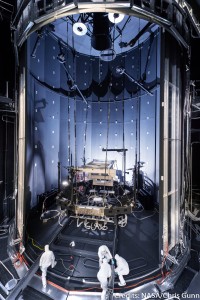As a specialist in thermal vacuum systems for space simulation, Dynavac is a longtime partner to the aerospace industry. However, our involvement with the monumental James Webb Space Telescope (JWST) program stands out as one of our most exciting projects.
A joint initiative between NASA, the Canadian Space Agency and the European Space Agency, the James Webb Space Telescope is the most powerful space telescope built to date anywhere in the world. This next-generation observatory will follow in the footsteps of its predecessor, the Hubble Space Telescope, witnessing the formation of planets and the first galaxies billions of years ago.
Preparing for the Coldest Place in the Universe
Currently, the JWST is undergoing final cryogenic testing in Chamber A at NASA’s Johnson Space Center in Houston to ensure it can withstand the extremely cold temperatures at its final destination—one million miles away from Earth. These temps can plummet to an astounding -387 degrees Fahrenheit, or 40 degrees Kelvin. Dynavac was instrumental in converting this vacuum chamber to support JWST testing before its launch in October 2018, constructing and installing a cryogenic wall that simulates temperatures as low as 30 degrees Kelvin using a helium refrigeration plant.
Creating the Cryogenic Wall
Built in Dynavac’s Hingham, MA facility, the completely assembled cold wall is 64 feet tall by 45 feet in diameter and is comprised of many panels of different lengths, many of which are up to 32 feet long. Each panel is coated with a special high optical absorptivity/emissivity black paint to enhance thermal exchange with the telescope.
From 2008 to 2011, under subcontract by NASA’s prime contractor Jacobs Engineering, Dynavac completed this multi-phase project, which also included construction of a large section of liquid nitrogen cold wall. “The size of the cold wall along with the program’s stringent thermal performance criteria introduced many complexities to the project,” said Dynavac Engineering Manager, Rob Pollara. “In collaboration with Jacob’s and NASA engineers, we were able to verify structural integrity and thermal performance of the cold wall prior to its construction.”
Dynavac’s field installation team then mobilized at Johnson Space Center to install the panels in Chamber A and make final welding connections to the extensive network of interconnecting piping.
Our team also supported several JWST program partners by building cold walls for other vacuum chambers to allow cryogenic testing of critical subsystems such as the Solar Shield, Integrated Science Instrument Module, and NIRCam instrument.
Tom Foley, CEO of Dynavac added “It’s exciting to be part of this project, and we’re proud of our contribution to such a historic program. Our team brought their expertise to the program and successfully executed all objectives to ensure flawless performance during testing.”
Visit the JWST website to see the temperature of the cold wall in real time as the telescope is being tested.
